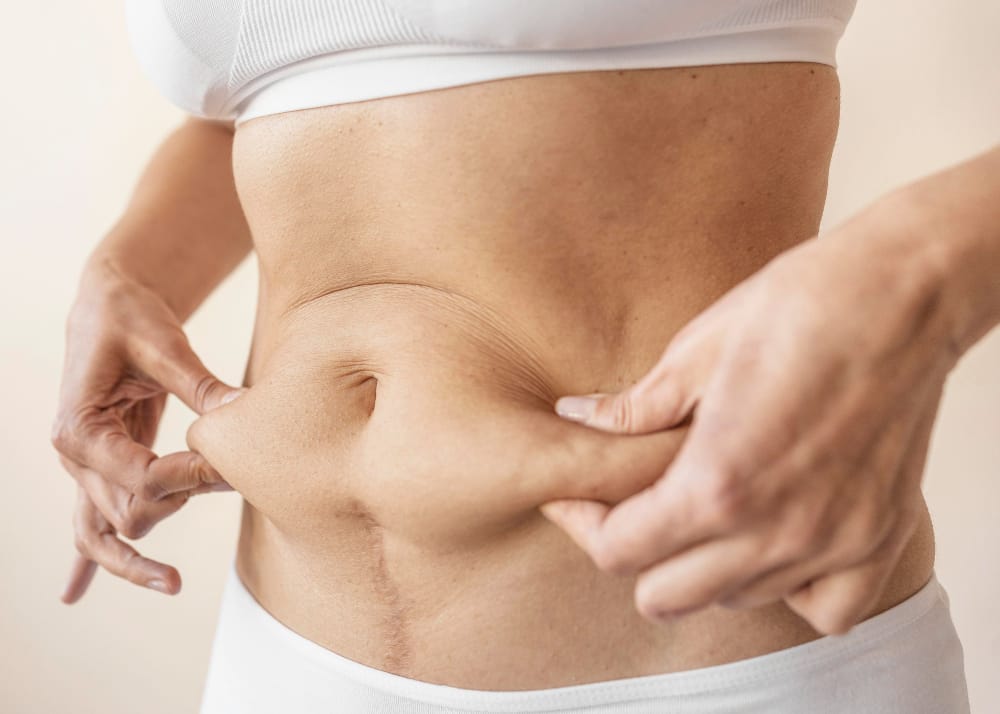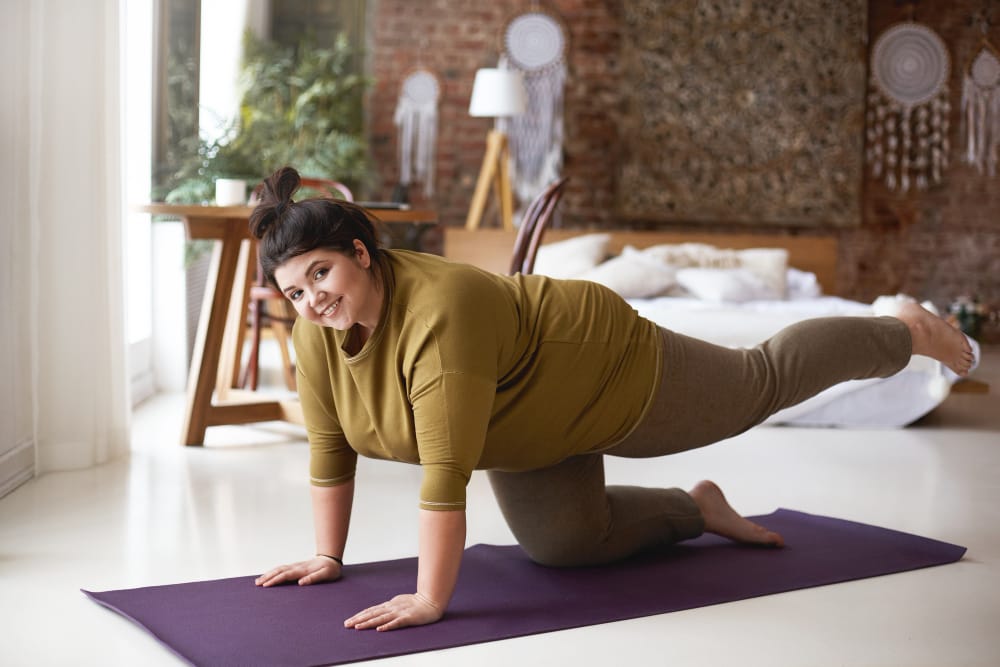After a c-section delivery, you need to wait for 6-8 weeks before starting any abdominal exercises to reduce belly fat. During this time, your body will try to lose a few pounds by getting rid of fluids in the body and sweating. Focusing on a good diet and sleep, walking regularly, using wraps, and getting postnatal massages can help you lose weight. After consulting with your doctor, you can start abdominal exercises that strengthen your core and reduce that belly. Yoga is another excellent way to strengthen those muscles and reduce stress.
Bringing a child into this world is no joke, and every mother gone through the process of keeping and growing their child in their womb knows it.
Whether vaginal or c-section delivery, the way your body changes after birthing your child, and the hanging belly and postpartum effects are things you should gradually figure out.
Your body just grew a baby, so experiencing a hanging belly and weight gain is normal. Important to remember here is to handle your body with love and care.
Losing belly fat and excess weight is a gradual process that differs from a vaginal delivery.
Let’s take a look at how your body sheds extra weight after childbirth and the steps you can take to get rid of this c-section pooch!
Weight loss after c-section

A C-section is a surgical process where the doctor makes incisions on your lower abdomen to get the baby out.
Depending on your situation, this cut could be a low-transverse or vertical, so this area is very sensitive for the first 6 to 8 weeks after birth.
Your doctor will probably tell you to take it easy, and you can resume your exercises once you’ve reached this mark.
But before we get into the exercise regime, let’s look at how your body will be losing weight on its own during this recovery period.
Depending on your body mass index (BMI), you should gain 11 and 40 pounds (5 to 18 kgs) during pregnancy with one baby and 25-62 pounds (11 to 28 kgs) when pregnant with twins.
- Initially, as the baby’s weight comes off, you’ll drop another few pounds right away when you lose blood, fluids, and amniotic fluid.
- During the first week, you’ll be running to the bathroom a lot and sweating, which will help you lose more pounds. Sweating increases as your pregnancy hormone levels drop.
- After one month, you would have shed around 20 pounds without too much effort, and another 2 weeks will make your tummy go back in more.
A couple of factors that help you lose more pounds are breastfeeding and moving around the house to do chores for your baby.
Breastfeeding isn’t only feeding your baby but also helps lose extra weight.
According to the Academy of Nutrition and Dietetics, breastfeeding moms use 400 to 500 calories daily to make the total amount of milk that most babies need from birth to 6 months of age. Continuous feeding for the whole 6 months will help lose body fat.
7 different ways to lose belly fat
1. Exercising
A difference between vaginal delivery and a c-section is to see how much pressure you can put on your lower abdomen, and this is why exercising after a c-section has some rules to it.
It would be best to start exercising only after receiving instructions from your doctor and ease into abdominal exercises.
It would help if you focused on strengthening your pelvic floor muscles that support your bladder, bowels, and uterus. Focus on the type of exercise that engages the core but doesn’t cause it to bulge out.
Avoid crunches, sit-ups, full push-ups, and planks at first, as these put a lot of pressure on the abdominal muscle and disrupt healing.
Also, avoid lifting heavy weights for the first 6-8 weeks after delivery.
Cardio is another great way to lose that belly fat and get back in shape. Start with low-impact cardio for the first 4-6 months after a c-section.
These include walking, swimming, cycling, and elliptical training. Let your stamina build-up and slowly increase the intensity.
Moving gradually and being consistent is the way to lose all the fat you want to lose.
2. Postnatal massage
Massages are a great way to strengthen muscles and help break up belly fat and release fluids from the lymph nodes, which can help in losing weight.
Lymphatic drainage can reduce swelling by removing fluids and waste products that need to exit your body after delivery.
A massage will help increase blood flow and oxygen in the body, ensuring faster recovery and improving immunity.
Body massages after a c-section boots blood flow and oxygen in the body, providing more rapid recovery and enhancing immunity.
Body massages are also known to help release endorphins in the body, which work as natural painkillers and oxytocin that stimulates your breast milk supply. A postnatal massage is usually recommended after two weeks when the scar has had some time to heal itself.
3. Walking
If not anything walking is one of the easiest ways to get your body moving and help lose all that baby weight if done right and consistently.
It increases your heart rate and blood circulation and doesn’t pressure your abdomen.
Walking uplifts mood as one also gets fresh air. You can walk solo while listening to music or a podcast or with family and friends.
4. Yoga

Yoga is one such form of exercise which you can do even during your pregnancy and after it when trying to recover. It helps strengthen muscles and reduce excess skin. Deep breathing exercises help relieve stress.
It helps tone your muscles and loose skin if the right area is targeted with different poses. Poses like bhujanga asana, pranayama, and suryanamaskar help keep the whole body toned and strengthen abdominal muscles. Learn from a professional or ask your doctor for advice before starting yoga.
5. Eating the right food
Keeping a balanced and healthy diet after childbirth is of utmost importance because of many reasons.
Not only do you need the nutrition-rich food to help heal your body and replenish it with vitamins, nutrients, and minerals, but it’s also essential to eat right to help in breastfeeding. Avoid junk food as much as possible.
Some healthy tasty snacks include:
- High fiber cereal to keep your system running smoothly
- Cut up fruits and vegetables
- A cup of yogurt with dried fruits in it
- A bag of veggies and hummus
- Whole-grain crackers with nut butter
6. Getting enough sleep
Sleep is essential for recovering from childbirth, and proper rest is needed for your body to rest and actively lose weight during waking hours.
A good sleep schedule allows your body to maintain a healthy metabolism required to lose weight.
Using a full-body pillow is a blessing in disguise for many moms out there as it supports during feedings and when trying to sleep to provide comfort to the abdomen.
A minimum of 6 hours of sleep is a must, so try to sleep whenever your baby sleeps.
Although the first few weeks are very draining so it’s best to have a family member help take care of a baby with you.
7. Belly wraps
Postpartum belly wraps bind and support the abdomen muscles and help in reducing the hanging belly by compressing it.
It might also help you reduce pain and improve your quality of life during that initial period after childbirth by improving your self-esteem.
Although there’s no proper evidence that using wraps will result in weight loss, it sure does aid you and your body when you’re trying to lose belly fat.
Some important things to keep in mind:
- Don’t wrap it too tightly, and if you feel uncomfortable, then take it off and try again or sitch the brands.
- Heavy compression can damage abdominal muscles and harm your body and pelvic floor. Damage to the pelvic floor can lead to organ prolapse and urinary or fecal incontinence.
- If you’re wrapping cloth and not buying a branded wrap, then you need to wrap it around a few times to get the same effect on your abdomen. Try wrapping from bottom to top to get the most impact on the abdomen.
- Try using elastic wraps as they’re easier to move in around and breathe easier too.
- Stop the wrap if it makes breathing difficult or causes dizziness or bleeding.
- Don’t use a wrap for any other area on the body.
Talk to your doctor before making any decision and clear doubts with your doctor before using a wrap.
8 core strengthening exercises
It isn’t easy to know where to start as you search everywhere for what kind of exercises you should start after getting your doctor’s approval. It’s important to understand that losing belly fat is gradual.
You need to target that excess skin around the belly button, and starting from basic exercises and slow intensity will be the right thing to do.
1. Breathing exercise
It’s essential to start with breathing exercises that help align with your body.
- Start on your back and relax your body on the floor.
- Take a deep breath through the nose, hold it for 3-5 seconds, then slowly release as you draw your belly towards the floor and contract your stomach muscles.
- Do this for 1-2 minutes daily to help strengthen your core muscles.
2. Glute bridge
- Lie faceup on the floor, with your knees bent and feet flat on the ground. Keep your arms at your side with your palms down.
- Lift your hips off the ground until your knees, hips, and shoulders form a straight line. Squeeze the glutes and keep your abs drawn in, so you don’t overextend your back.
- Hold this position for 5-10 seconds before lowering back down.
3. Wall push-ups
- Start with your feet and legs together, standing about 2 feet from a wall with your arms straight out in front of you.
- Your palms should be placed on the wall at about shoulder-level height as well as shoulder-width apart. Your fingers should be pointed to the ceiling.
- Bend your elbows and begin to lean your body toward the wall until your nose almost touches it.
- Hold for 3-5 seconds in this position before pushing back to the starting position.
4. Seated forward bench
- Begin seated, with both legs extended straight out in front of you. Press your heels actively down into the ground and flex your feet.
- Inhale to extend your arms up overhead and sit tall.
- As you exhale, hinge at your hips to fold forward over your legs, maintaining length along your spine. You can either leave the palms face down on the floor or reach towards the ankles or outer edges of the feet. Keep your shoulders back and relaxed away from your ears.
- With every inhale, find more length along your spine. With every exhale, move more deeply into your forward fold. Stay in this position for 5-10 seconds.
5. Wall sits
- Make sure your back is flat against the wall. Place your feet firmly apart and about 2 feet out from the wall.
- Slide your back down the wall while keeping your core engaged and bending your legs until at a 90-degree angle. Your knees should be directly above your ankles.
- Hold this position for 10-15 seconds while contracting your ab muscles. Slowly come back to a standing position while leaning against the wall.
6. Kneeling squats
- Start from a kneeling position with knees about shoulder-width apart and feet straight behind your knees. Engage your core muscles to keep your back and spine neutral and your torso tight and upright.
- While activating the glutes, sit back slowly and control your heels.
- Contract your glute muscles to push up and return to the upright position.
7. Modified side planks
- Begin on your hands and knees, with your wrists under your shoulders and your knees under your hips.
- Extend your left leg behind you at the height of your left hip. Externally rotate the lifted leg, turning your left toes and knee out to the side.
- Inhale and press down through your right hand and knee as you lift your left arm up, stacking the shoulders and hip.
- Hold this position for 5-10 seconds. Lower back down onto your hands and knees to repeat this plank on the other side.
8. Chair tricep dip
- Sit on the edge of the chair and grip the edge with your hands.
- Extend your legs with your heels on the floor. Hold yourself up using your triceps. Just slide forward far enough that your behind clears the edge of the chair.
- Lower yourself until your elbows are bent between 45 and 90 degrees. Hold this position for 3-5 seconds and slowly rise back up to starting position.
FAQs
What surgery removes the c-section pouch?
A tummy tuck (abdominoplasty) is one of the top five cosmetic surgical procedures in the US women opt for after childbirth.
Those going for a c-section find it ideal to combine it with a tummy tuck instead of two separate surgeries.
It’s best to get a tummy tuck only if you know you won’t be planning another baby.
Otherwise, it’s futile to go through this process.
Sometimes women find it more beneficial to get the tummy tuck after a c-section when they have recovered a bit and have gone back to their healthy selves after enjoying a considerable time with their new baby.
Does the mommy pooch ever go away?
The abdominal muscles are stretched to the max to create space for your baby during pregnancy.
The pooch takes some time to disappear after the delivery, whether a c-section or vaginal delivery.
In the first few weeks, the body itself tries to contract this pooch, and your body tries to shed the pounds gained.
But after a while, you’ve started making efforts to get rid of this pooch completely.
When your doctor allows you, start focussing on workout for your abdomen, eat well, and sleep plenty to reduce the mommy pooch.
If the pooch still doesn’t go away, discuss a tummy tuck with your doctor.
What foods help postpartum recovery?
Our body goes through a lot after childbirth and needs the energy to take care of the baby.
The body needs to recover from birth, but it also needs nutritional food to produce quality breastmilk.
Food is given utmost importance in this recovery period.
– Whole grains and soaked and sprouted grains (rice, millet, quinoa, oats, amaranth)
– Nuts and seeds (almonds, walnuts, flaxseeds, pumpkin seeds, brazil nuts)
– Healthy proteins (organic eggs and chicken, grass-fed beef, wild salmon, sardines)
– Seaweed
– Legumes soaked to prevent gas (black beans, adzuki beans, chickpeas)
– Coconut and sesame oils and ghee for cooking vegetables
– Olive oil for drizzling over grains or veggies
– Bone broth (a nutritional powerhouse and good for just about anything)
To summarize
It’s challenging for all moms to juggle the responsibility of caring for their newborn baby and focussing on their body to bring it back to what it was before pregnancy.
In the beginning stage, our bodies work themselves as our hormones try to balance, so the body itself sheds some extra pounds.
Continuous breastfeeding also helps. But a c-section requires careful attention to the abdomen, and only after it has healed completely and a few weeks have passed can you start exercising.
A regime of exercise, good food, and plenty of rest can help you reduce all the nagging belly fat. But what needs to be focussed on is that our bodies change a lot during pregnancy, so going back to what it once was will require time, patience, and love!


